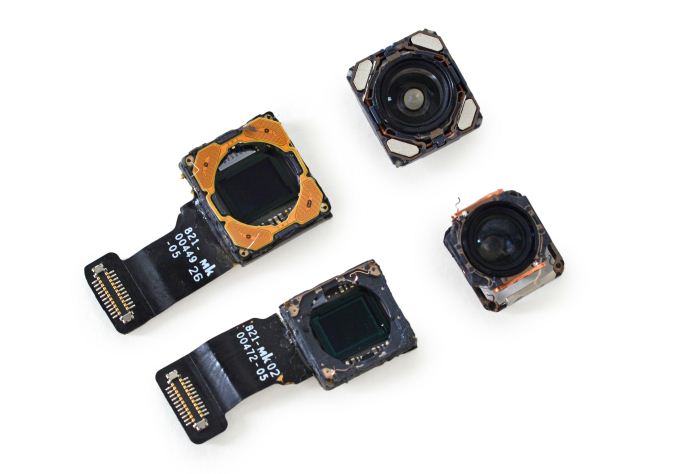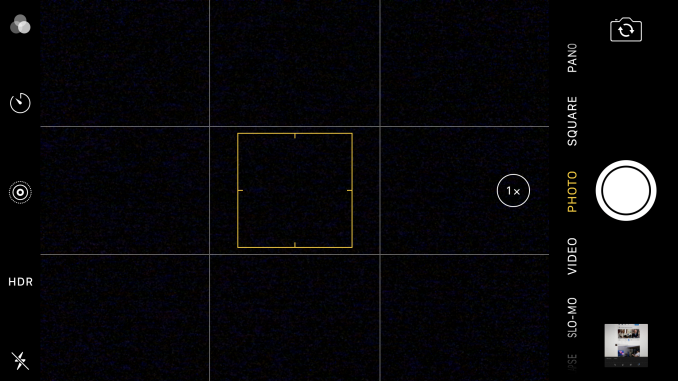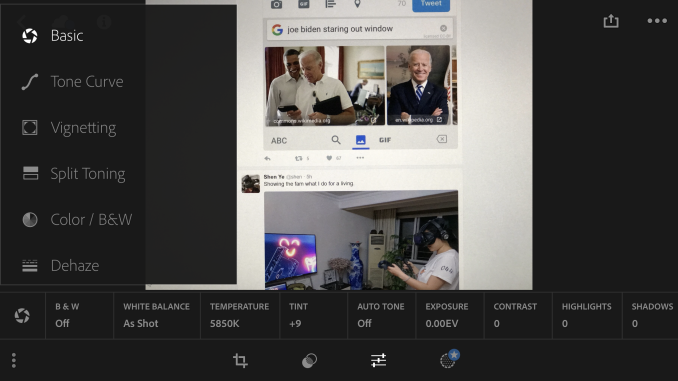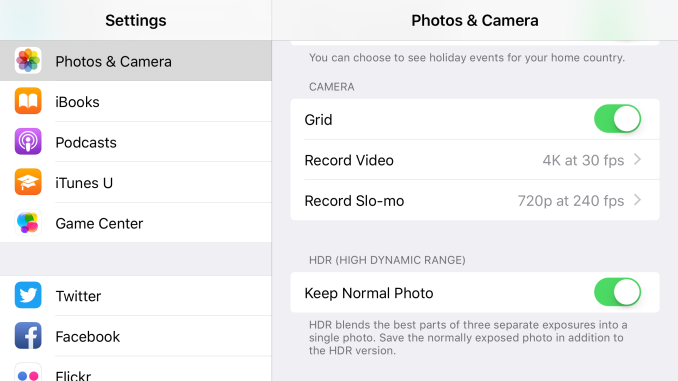The iPhone 7 and iPhone 7 Plus Review: Iterating on a Flagship
by Joshua Ho & Brandon Chester on October 10, 2016 8:00 AM EST- Posted in
- Smartphones
- Apple
- Mobile
- iOS
- iOS 10
- iPhone 7
- iPhone 7 Plus
Camera Architecture
Before we get into the results of the camera output it's always helpful to actually examine the basic characteristics and hardware that make up the camera as a number of characteristics can be predicted or understood by looking at the basic hardware. The CIS technology used can have significant impacts on noise, active area, and a number of other features including slow motion video capture. However, to say that the CIS is the only area worth examination ignores the whole chain of hardware and software needed to make a great camera. With that said we can start our look at the camera with the table below which summarizes a number of high level details for the camera.
| Apple iPhone Cameras | ||||
| Apple iPhone 6s Apple iPhone 6s Plus |
Apple iPhone 7 Apple iPhone 7 Plus |
|||
| Front Camera | 5.0MP | 7MP | ||
| Front Camera - Sensor | Sony ? (1.12 µm, 1/5") |
Sony Exmor RS (1.0 µm, 1/?") |
||
| Front Camera - Focal Length | 2.65mm (31mm eff) | 2.87mm (32mm eff) | ||
| Front Camera - Max Aperture | F/2.2 | F/2.2 | ||
| Rear Camera | 12MP | 12MP | ||
| Rear Camera - Sensor | Sony Exmor RS (1.22 µm, 1/3") |
Sony Exmor RS (1.22 µm, 1/3") |
||
| Rear Camera - Focal Length | 4.15mm (29mm eff) | 4mm (28mm eff) 8mm (56mm eff) Secondary |
||
| Rear Camera - Max Aperture | F/2.2 | F/1.8 F/2.8 Secondary |
||
Looking at the camera of the iPhone 7 in some ways the cadence has changed up a bit. While the iPhone 5s to iPhone 6 transition saw the use of almost identical camera sensor and optics, the iPhone 7 actually changes things up relative to the camera that we saw in the iPhone 6s, likely because the difference between the iPhone 6 and 6s camera was fairly mild in still photos. The iPhone 7 still appears to use a similar sensor on the rear, but with a new set of optics that incorporates a wider aperture. Apple seems to be fighting against serious z-height limitations, so we’re continuing to see a reduction in focal length as the iPhone 7 is now basically comparable to phones like the One M7 with its 28mm equivalent focal length. It’d be interesting to know transmission efficiency which would allow for proper comparisons between generations but considering how most dSLR lenses don't' list these specs it's not a surprise that we don't see this kind of disclosure.

iPhone 7 Plus's dual camera modules (Image Courtesy iFixit)
What isn’t listed on the spec sheet is that the iPhone 7 now has OIS, which is going to be a serious step up in terms of performance for anyone upgrading from the iPhone 6 or 6s. While Apple has some proprietary EIS that allows for really impressive performance despite the lack of OIS, a physical mechanism to compensate for hand shake is going to make for a more effective system in the first place, as it fixes the problem before the photons are captured. Apple continues to use advanced software to enable long exposure without visible blur or hand shake so the addition of OIS shouldn’t have any noticeable drawbacks other than increased shot latency in low light.
Of course, the iPhone 6s Plus already had OIS, so for the iPhone 7 Plus there is a new secondary camera with a focal length that is twice as long as the primary camera. However, the aperture is smaller, which means that in low light the system is going to automatically fall back to the primary camera which is still better in low light as far as I can tell, especially because the second camera lacks OIS. However, in bright daytime conditions the second camera’s longer focal length allows for better portraits and better detail in general. This helps to compensate for the iPhone’s sensor size and z-height limitations, but can only really help in daytime conditions.
Interestingly enough, Apple is actually one of the first OEMs to my knowledge to adopt a 1 micron pixel pitch for a camera sensor, but this is being done for the front-facing camera. I’m kind of curious to know what led to this decision as the optics are probably not going to be able to resolve such a small pixel size. We generally don’t review front-facing cameras but for the people that care about this sort of thing I suspect that the FFC is mostly a sidegrade in the sense that it’s probably going to be used to enable higher resolution video capture rather than higher quality still photos.
Camera UX
As far as the camera application goes, there’s really nothing new this generation. If you’ve taken pictures with a relatively new iPhone, you’re going to be right at home with the iPhone 7’s camera UI. For those that haven’t used a relatively new iPhone before we can do a quick review to discuss what is and isn’t present. At a high level, the UI is split up into a few logical sections, with mode-specific options in their own section. Modal selection is on the opposite side, with text that fairly clearly delineates the purpose of each mode. Below the modal selection, general options are presented for things like changing between front and rear cameras as well as the shutter button and camera roll.
It's hard to really say much about the iPhone camera UI at this point because it’s been polished to the point that there’s really no obvious criticisms to make about it. Apple may have made the mistake of shipping a 16:9 preview for a 4:3 camera before, but it’s been years since glaring issues like that have come up. Tapping to focus allows for either locking focus and exposure or biasing the exposure, which is going to provide coverage for 95% of still image cases. Of course, if you want more fine adjustment the default camera app is going to be inadequate, but there are plenty of good manual camera applications on the market like ProCam, ProShot, and Manual Camera.
It’s worth mentioning that while Apple was far from first to implement RAW capture on smartphones, their implementation is differentiated by a real end to end solution. Something like the HTC 10 really needs Lightroom to bring out the best in its RAW captures, although Snapseed is still reasonably useful in a pinch. Apple is leveraging their ecosystem which allows for things like fully featured Adobe Lightroom for RAW processing. I thought for a very long time that processing RAW was infeasible in the context of a smartphone TDP without fixed-function hardware, so it’s incredibly impressive to see Lightroom working smoothly when processing RAW images.
While most of the camera UX is designed well, one noticeable issue here is that the camera settings are integrated into the settings application rather than the camera application itself. If you’re used to how iOS works this makes sense, but things like resolution settings for video are placed in this menu rather than integrated into the camera application which makes switching between these settings relatively painful if you’re used to something like the HTC 10’s camera UI which places resolution settings in a slide-out drawer. This isn't a huge issue but it's definitely something I noticed due to the need to rapidly switch between resolution settings for video testing. Your mileage may vary here if you don't particularly care for such issues. Overall though, the camera UX has few friction points.













377 Comments
View All Comments
UtilityMax - Wednesday, October 12, 2016 - link
They don't the same OS, but they often run the same applications, so the comparisons are valid. For example, there exist the same web browser benchmarks that run on both OSes.Constructor - Monday, October 17, 2016 - link
On top of the faster CPUs, iOS is also optimized for more efficient resource use plus several special 64 bit optimiziations.Especially memory garbage collection on Android was a bad design mistake which keeps devices stuttering at random intervals.
ACM.1899 - Wednesday, October 12, 2016 - link
"the headphone jack because that’s what users say they want."i have bunch of nice earphones at home and i don't need (want) to buy BT headphones.
they removed the 3.5mm jack and what did they add instead? at least a built in dac (like HTC 10, v10 or v20) would have been nice.
i've heard the sound through the dongle isn't as good as iPhone 6s.
or bluetooth headphones (in general) are not as good as analog headphones (with the same price).
every time Apple does something stupid we say it's because of this or that or for that you can do this or it's the future....but WHY?
for now the only (main) reason is marketing.(Apple & Beats)
as long as a good BT headphone is not the same price as a good analog headphone , i don't want them.
until then the 3.5mm jack should have not been removed.
at least i don't need that bs taptic engine...
ACM.1899 - Wednesday, October 12, 2016 - link
or if Audio (through a smartphone) is that important to me , i can buy an android phone.btw i guess they won't remove it from the mid-range iPhone (SE).
serendip - Wednesday, October 12, 2016 - link
That Redmi Note 3 will be staying at the top of the WiFi web browsing chart for a while longer. How the heck did AT get 12 hours? I've got the same phone and the longest I've seen is 10 hours on WiFi with LTE on but not enabled for data.zodiacfml - Wednesday, October 12, 2016 - link
I love your conclusion piece. I still hate Apple but they are commendable for the constant SoC improvement and the large die size of it. I'd get over the missing headphone jack if the quality of the adapter is good. They did an awesome job on the display too, extracting the best possible performance from the display. I'd get goosebumps if they would the same attention to detail using AMOLED displays for the next generation.I never warmed to the Google Pixel devices as they are too expensive with the unimpressive Snapdragon 821 or 820. I'd just get an S7 Edge for the hardware. The software part is the only missing piece as I'd rather have stock Android with yearly, latest updates from Google.
UtilityMax - Wednesday, October 12, 2016 - link
SoC improvement is fine, but how much SoC improvement do people really need? It's not like smartphones are running PC games or are using for engineering design work. A three year old Nexus 5 with its Snapdragon SoC is still perfectly adequate as a daily smartphone when SoC is concerned. Now, the SD820 offers about twice the performance.blackcrayon - Wednesday, October 12, 2016 - link
How much? An infinite amount. It has to keep increasing in order for smartphone operating systems to get increasingly better. One example is using CPU power to increase photo quality. But no one wants to wait 10 seconds between shots...UtilityMax - Wednesday, October 12, 2016 - link
Your argument is useless because not even a one year old Nexus 5X with a much criticized Snapdragon 808 SoC does not need to take so much time to take a picture. Any modern smartphone has a pretty adequately fast camera. If you find a smartphone with a slow camera that's not an excuse to buy an overpriced iphone with no expandable storage, no "approved" way to upload your media into it without using the iTunes junk, and no 3.5mm headphone jack.blackcrayon - Wednesday, October 12, 2016 - link
Your counterargument is u... nevermind.You need to research what happens when you take a photo on a modern smartphone. There is a lot of processing done in software, which of course utilizes the hardware, to achieve better photos than would be possible without it. I'm not sure what you think your comparison means though. An iPhone "1" could take pictures too. It doesn't mean it could do the kind of instantaneous post processing something like an A10 can do. In this particular case it's Apple's ISP doing much (most?) of the work, but the analogy still stands. In order to add enhancements to the device that can work without drawbacks, they have to be fast. The more speed you have to spare, the more cycles you can use on things like instantaneous image processing, compression/decompression, "AI" that works locally on the phone, etc.
Anyway, the Nexus 5X running Chrome alone should tell you SoCs aren't fast enough, especially with a poorly optimized app.